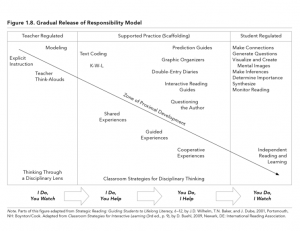As experienced teachers, we intuitively know many approaches to helping our learners engage with content. Occasionally, we discover scientific, research-based strategies that reflect what we intuitively know. Now with brain-research and increased knowledge in how people learn, we are able to extend our practice to include new strategies. The purpose of this article serves to provide insights and suggestions for activities that bridge learning for students through scaffolding based on Vygotsky’s Gradual Release of Responsibility Model (1978).
Scaffolding
In education, scaffolding refers to using a variety of instructional strategies to create stronger understanding and greater independence for students in the learning process. Scaffolding, as a metaphor, describes the process of instructors providing successive levels of temporary support that help learners reach higher levels of comprehension and skill acquisition that they would not be able to achieve without assistance (Abbott, 2014). Like physical scaffolding, the support strategies are incrementally removed when they are no longer needed. The instructor gradually shifts more responsibility over the learning process to the learners. Teachers typically break up a learning experience, concept, or skill into discrete parts, and then give learners the assistance they need to learn each part. Often, scaffolding creates the bridge between learning gaps and constructing new knowledge (Abbott, S, 2014).
Zone of Proximal Development
In Vygotsky’s theory regarding the Zone of Proximal Development (1978), learner’s current level of knowledge relates to skills, concepts, and/or knowledge a learner brings to a new situation. According to Vygotsky, learners need to stretch slightly beyond their comfort level to learn new information. The critical element about the Zone of Proximal Development (1978) is that if learners are stretched beyond what they can reach, they become frustrated and confused and struggle to master the new skills and concepts. Students who are not able to grasp new levels in learning often suffer negative emotions. By scaffolding new learning, instructors empower students to be able to grasp new skills, concepts and knowledge.
Gradual Release of Responsibility Model
Vygotsky’s Gradual Release of Responsibility Model ( from the book Developing Readers in the Academic Disciplines by Doug Buehl) depicts the different levels of learning from teacher regulated to supported practice to student regulated. This model illustrates many of the intuitive practices instructors use and for the purposes of this article, strategies that bridge and support practices will be shared. Hopefully, readers will find a few strategies that may supplement their current methods of instruction enhancing student learning and learning outcomes.

Lectures – Teacher Regulated
Teacher regulated practices often come in the form of lectures. At an earlier stage in teaching,instructors were expected to be the ‘sage on the stage’ whereas now, research amplifies the need to engage learners throughout the learning process. Adjustments to the lecture delivery mode can enhance student learning. Flipping your classroom is one instructional strategy that meets the needs of many learners. By using voice over powerpoint, Lecture Capture or Camtasia, an instructor can record their lecture making it available through Moodle prior to teaching the lesson. This allows learners to listen to the recorded lecture multiple times to enhance learning. Students with learning difficulties greatly benefit from being able to learn at their own pace and also review sessions while preparing for tests. Additionally if instructors require students to view the recorded lecture, the instructor may then use valuable in-class time to bring learning to a higher level rather than just introducing material. Viewing the lecture prior to class and using a double-entry diaries allows students the opportunity to take notes, jot down questions and clarify information during in-class instructions. Repetition transfers information from Sensory Memory to Working or Short-term Memory to Long-term Memory.
Supported Practice – Scaffolding
Another important concept in lectures focuses on teaching what is MOST important — need to know versus nice to know. This emphasis on major ideas and key concepts models for learners critical information. For students who have difficulty with discerning key information, this strategy demonstrates what is most important.
Chunking
Additionally, based on brain research, instructors need to chunk lectures into 10-15 minute increments. When instructors engage students after 10 minutes, studies have found that students long-term memory increases. Follow 10 minute chunks with a variety of reinforcing activities such as using graphic organizers to conceptualize information or use inquiry questions in think-pair-share or group activities for discussion.
 Visual and Mental Imagery
Visual and Mental Imagery
Lectures can also be greatly enhanced by using a variety of imagery. According to Reynolds (2015) in Presentation Zen, “if we want to communication with more clarity, integrity, beauty, and intelligence, then we must move beyond what is considered to be “normal” to something different and far more effective.” Reynolds recommends three key points; restraint in preparation, simplicity in design and naturalness in delivery (2015, p. 7). To demonstrate, restraint in preparation often reflects the idea of less is more. In preparing slides or images, choose images that provoke curiosity or make an outstanding point. The brain loves novelty so creative images catch the mind’s-eye. Also, with simplicity in design, limit print and images to only portray the main concepts; again, less is more. Think of Steve Jobs Apple Icon and how the image represents bringing the universe to a user through Apple Computers. While our classroom content varies from advertising, the principle is the same; use images that represent the content concepts. These images will create links for learners in their long-term memory.
Finally think of presentations as an opportunity to share a story or analogy. An effective presentation allows us to amplify the meaning of our words (Reynolds, 2015). The presentation visuals, the structure, and the story are compelling aspects of a presentation. In the non-verbal portion create a contact with your audience through eye contact, facial expressions and passion for your subject. Well-crafted and engaging presentations can teach, persuade, and inspire.
Student Regulated
In closing, use reinforcing activities to enhance learning. As noted in the Gradual Release of Responsibility Model, follow-up activities help cement learning. Use a 3-2-1 wherein students write 3 things they learned, 2 things that they can apply and 1 thing they need clarified. Students can also respond in the Discussion Board to an inquiry question posed in today’s lesson. As students become more self-regulated, require learners to think at a higher level: to synthesize, make inferences or evaluate key concepts and/or theories bringing their learning to an internalized lens. At this last stage, learners can demonstrate their mastery through final projects, case study analysis, collaborative learning discussions or team projects. By being aware of our students needs and the need to scaffold the learning process, instructors will be able to design instruction to assure success for a multiple of learners.

